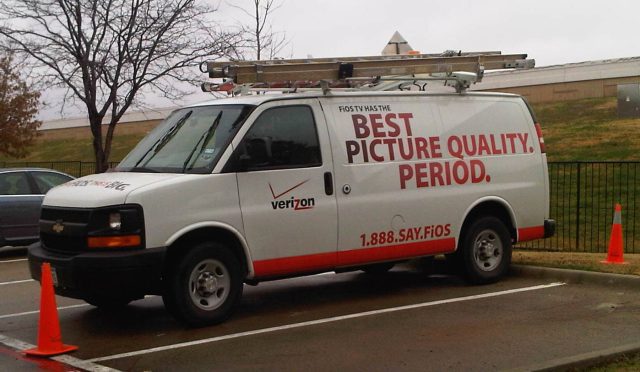
It's been nearly five years since Verizon decided to stop expanding its FiOS fiber network into new cities and towns, so this week's news won't come as a huge surprise: Verizon is nearing "the end" of its fiber construction and is reducing wireline capital expenditures while spending more on wireless.
"I have been pretty consistent with this in the fact that we will spend more CapEx in the Wireless side and we will continue to curtail CapEx on the Wireline side. Some of that is because we are getting to the end of our committed build around FiOS, penetration is getting higher," Verizon CFO Fran Shammo said yesterday in the Q4 2014 call with investors.
Wireline capital spending totaled $1.6 billion in the most recent quarter and $5.8 billion for 2014, down 7.7 percent from 2013, Verizon said.
Verizon posted a net loss of $2.23 billion in Q4 2014, despite making a profit of $9.63 billion for the full year. The loss included "significant non-operational items... primarily related to the annual actuarial valuation of benefit plans and mark-to-market pension adjustments," Verizon said.
The numbers look better when examining individual divisions. Wireline operating income margin was 4.4 percent in Q4 2014, up from 1.2 percent the previous fourth quarter, Verizon's earnings announcement said. FiOS revenue grew 11.6 percent year-over-year to $3.3 billion in Q4 2014, and FIOS brought in 77 percent of consumer wireline revenue.
Those profitability numbers pale in comparison to wireless, where Verizon reported 23.5 percent operating income margin in Q4 2014. That helps explains why Verizon is shifting capital expenditures from wireline to wireless. Verizon Wireless added 2.1 million retail connections in the fourth quarter, bringing its total to 108.2 million. Among those are 35.6 million retail postpaid accounts, averaging 2.87 connections per account for 102.1 million postpaid connections.
Although FiOS competes strongly against cable companies like Comcast, the expense of replacing old copper lines with fiber led Verizon to stop building in new regions and to complete wiring up the areas where it had already begun. Verizon even partnered with cable companies in 2012 to resell cable service in bundles with Verizon Wireless in areas where FiOS was never built.
Verizon doesn't seem to want to maintain its copper telephone network either, with many customers and advocacy groups complaining that the company drags its feet in fixing problems in order to force users onto fiber or wireless.
Verizon is reaping the financial rewards of FiOS now that it has mostly finished construction.
"We are reconnecting homes that we've already connected, so it's not additional capital that we have to outlay," Shammo said. "That is a very good return for us because we already spent the capital to connect that home." Verizon's plan "to improve profitable growth includes driving further FiOS penetration and improving operating and capital efficiency."
Fifty-nine percent of FiOS consumer Internet customers subscribed to data speeds of at least 50Mbps, up from 46 percent one year earlier.
Verizon says that FiOS lines have passed more than 19.8 million premises. FiOS Internet has nine percent more Internet connections than it did a year ago and 7.4 percent more video connections.
"In broadband, we added 145,000 net FiOS customers in the quarter and 544,000 for the year," Shammo said yesterday. "We have a total of 6.6 million FiOS Internet subscribers, representing 41.1 percent penetration... Overall net broadband subscribers increased 59,000 in the quarter and 190,000 for the full year. In FiOS video, we added 116,000 net customers in the quarter and 387,000 for the year. We have a total of 5.6 million FiOS video subscribers, which represents 35.8 percent penetration."
(The penetration percentages don't square with the 19.8 million buildings passed figure. Verizon told Ars that out of the premises passed, 16.1 million homes are "open for sale" for Internet service and 15.8 million are open for sale for TV. Some homes are passed with fiber but aren't ready for services because network gear in the central office hasn't been initialized. Premises passed include also businesses. Verizon said the 19.8 million buildings passed with fiber are "vastly" homes but declined to say how many are businesses, and would not say how many homes are passed with copper.)
Verizon has converted more than 800,000 copper customers to fiber since 2011 and said it intends to convert another 200,000 in 2015, though that number would likely be higher if Verizon hadn't halted its fiber expansion. Customers can switch to fiber without purchasing FiOS service, as fiber can carry circuit-switched telephone calls—but without the benefit of working throughout multiple-day power outages, as older copper lines could do. Even if customers switch to fiber for phone service only, those conversions "provide a long-term opportunity for customers to purchase FiOS services," Shammo said.
reader comments
131